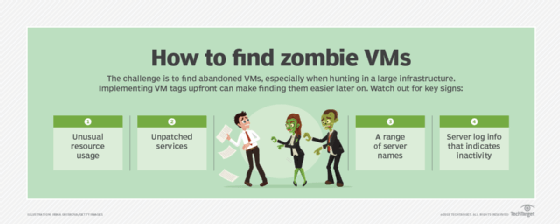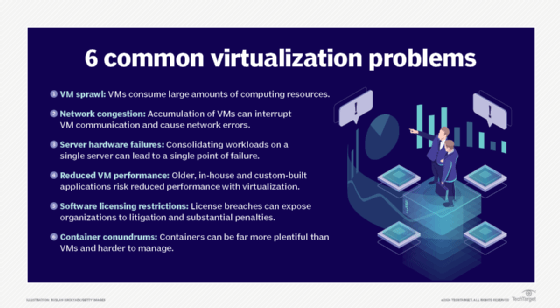What is server sprawl and how to prevent it?
What is server sprawl?
Server sprawl is when multiple underutilized servers take up more space and consume more resources than can be justified by their workload.
Common causes of server sprawl include the deployment of a large number of inexpensive, low-end servers and the practice of dedicating servers to single applications. Server sprawl may be confined to a single server room, but it can, in some cases, be spread across multiple facilities in widespread geographical locations, especially in cases where one company has acquired another one or where two companies have merged.
Server sprawl occurs when an organization's server resources are routinely not being used to their full capacity and when those resources exceed the organization's actual requirements, even at peak use. Server sprawl can be harmful to organizations, adding expenses of running, administering and maintaining unneeded physical or virtual servers. Server sprawl can be harmful in other ways when enterprise computing is not consolidated.
Why is server sprawl a problem?
Having multiple servers in an organization is not always an indicator of server sprawl. Different physical servers are often needed for different functions, including data processing, data storage, networking functions and others.
Server sprawl is more likely to occur when these functions are spread across more servers than needed -- for example:
- Similar server workloads that run on more than one server in parallel can be costly. For example, this can occur when an organization has legacy web servers or email servers related to mergers or acquisitions.
- Enterprise storage that is fragmented across different servers can require added resources to consolidate results from multiple servers.
- Servers that were originally provisioned to accommodate peak computing demand, which may vary over time, can be costly, especially when peak demand drops over time.
While having multiple servers can be beneficial for ensuring computing redundancy and high availability (HA), unmanaged server sprawl can cause problems beyond increased costs of running the unneeded servers.

Costs of server sprawl
Server costs don't scale directly with server utilization. For example, running 10 servers at 10% capacity each costs much more than running two servers at 50% capacity each. Each server -- whether deployed as a virtual system or physical server -- has fixed overhead costs, as well as variable costs. Server sprawl costs include the following:
- Infrastructure costs. The costs of keeping a server up and running include powering the server itself, as well as added costs for cooling the data center in which the server is running. Network connectivity and facilities costs for underutilized servers also escalate with server sprawl.
- Administration costs. Server sprawl can increase administrative costs. Software licensing fees, system administration tasks, maintenance and access control increase proportionally to the number of servers.
- Business costs. Server sprawl can cause applications to produce incomplete results -- for example, when business data is not fully replicated across different servers. Unneeded servers can also expose an organization to security vulnerabilities.
- Opportunity costs. Resources spent on unneeded servers can't be used to make more productive investments for the organization.
Having more server capacity than ordinarily required may be part of a business strategy -- for example, when servers are replicated for redundant backup or when idle servers are maintained in readiness for periodic surges in demand. However, server sprawl is more often the unintended consequence of unplanned events rather than the result of a well-thought-out strategy for maintaining HA or responding to surges in demand.
How to prevent server sprawl
Detecting server sprawl in a growing organization can be difficult, especially with the increasing reliance on cloud and virtualization technology to deploy virtual servers and cloud server instances that may replicate or overlap functions of existing servers. However, careful planning can help reduce the impact of server sprawl, while still enabling an organization to plan for peak demand.
One of the most important strategies to fight server sprawl is server consolidation. Server consolidation usually involves identifying servers in the organization and then reducing the number of physical servers, while also migrating or virtualizing disparate server workloads.
Other strategies to fight server sprawl include the following:
- Consolidate hardware. Start by identifying all the physical servers in data centers, and determine how much of their capacity is being used. Separate application servers can often be consolidated on a single more powerful server.
- Virtualize servers. Individual servers can also be consolidated and provisioned as separate server workloads on a powerful server. Overreliance on virtualization can bring its own virtual sprawl problems, so virtual servers should be provisioned with care.
- Use software-defined infrastructure. Use software-defined infrastructure tools to better manage and adapt to changing server needs.
- Use information technology (IT) asset management and capacity planning tools. Careful management of IT assets and use of capacity planning tools can help stop server sprawl before it starts. These tools can help track existing servers and identify when a server is running below capacity -- or identify when demand for a server is peaking and the server needs to be augmented.

Getting server sprawl under control can be far more complicated than preventing server sprawl in the first place, so the sooner an organization can implement a plan for managing server growth, the better off it will be.






